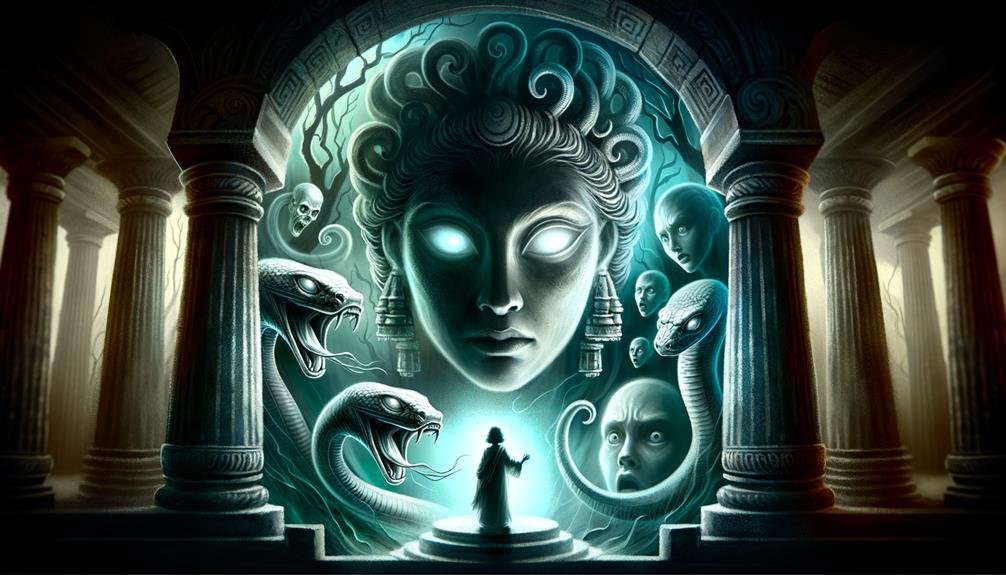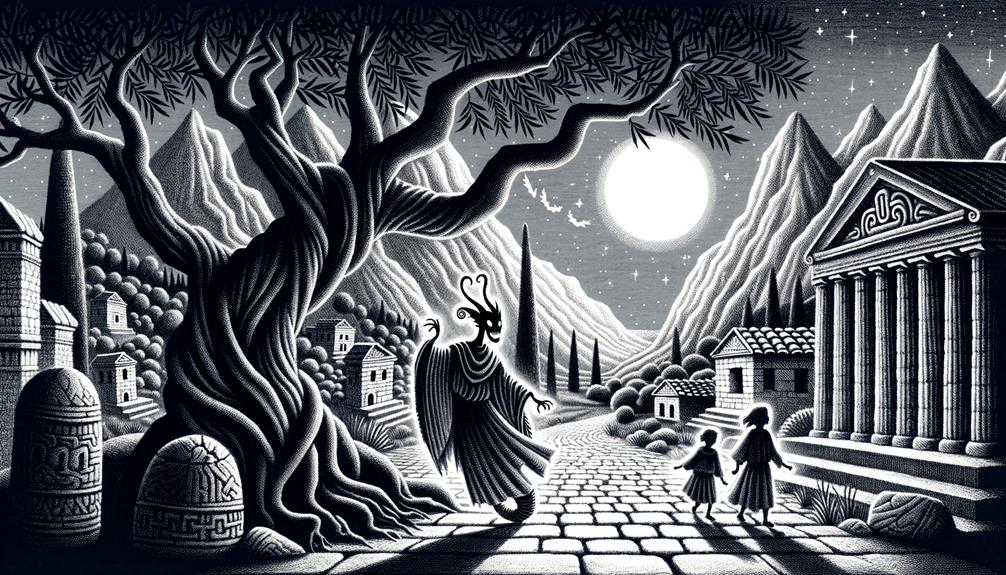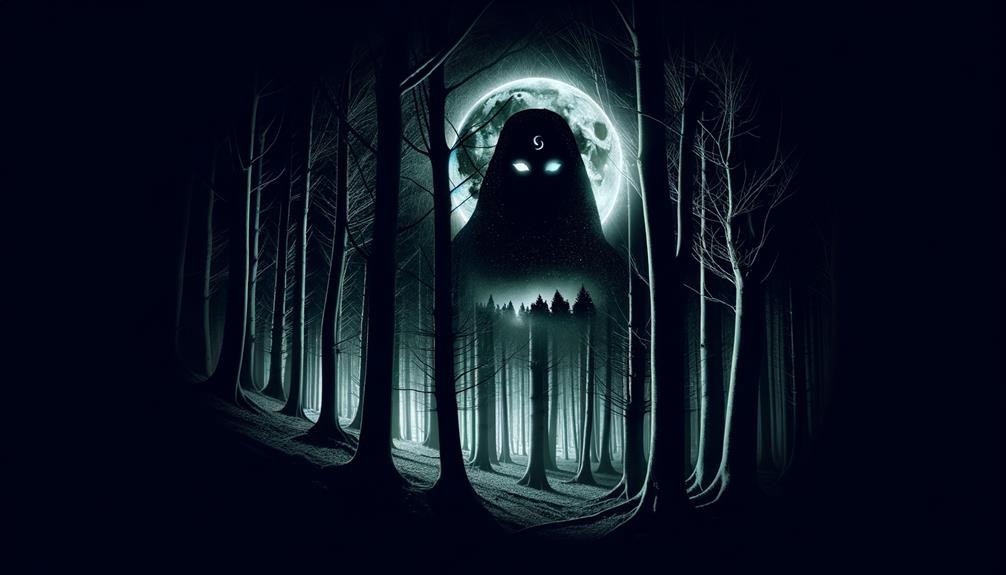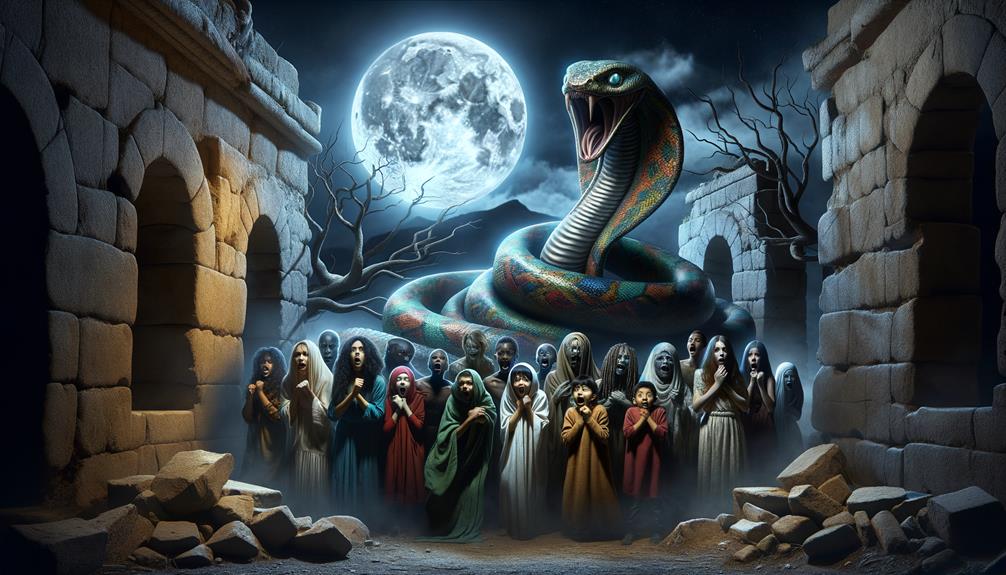Lamia's tale in Greek mythology is a fascinating, albeit grisly, one. She started off as a breathtaking queen, but a twist of fate, tied with Hera's envy, turned her into a part-snake, part-woman creature. Drawing parallels to Lamashtu, a demoness from Mesopotamian mythology, Lamia's story took a unique turn. Instead of just one, her legend came to encompass a group of child-devouring spirits, known as the Lamiai.
Interestingly, her narrative has shaped how we view demons today, especially vampires. One intriguing detail about Lamia is that she had the ability to take out her own eyes, and she possessed the gift of foresight. Her saga is a vivid tapestry of fascination, sadness, and fear. It's intriguing to look further into her myth to truly appreciate her multifaceted persona.
Origins of the Lamia Myth
When one digs into the roots of the Lamia myth, it's quite captivating to find that Lamia's name might have a connection to her role as a spirit that roamed the night. She was often depicted as a monster that consumed children in Greek lore. Lamia's character in Greek mythology is quite layered and complex, with her image transitioning from being a singular creature to a group of night-roaming spirits known as the Lamiai, who had vampiric tendencies.
If we examine her lineage, we can find ties to multiple areas and cultures within the realm of classical mythology. For instance, Lamia's equivalent in Mesopotamian mythology is the demoness Lamashtu, and studying the similarities between them is quite absorbing. Much like Lamia, Lamashtu was infamous for being a child-eater and a spirit that haunted the night, suggesting that the two myths might have a common origin.
However, the transformation of Lamia from a singular creature to a group of child-eating spirits is a feature unique to Greek mythology. The shift from one Lamia to multiple Lamiai could be seen as a cultural adaptation intended to increase the fear associated with her, turning her into a more widespread menace.
Lamias Transformation and Powers

We can get a lot out of studying the story of Lamia, a character from Greek mythology, particularly her transformation and the supernatural abilities she gained. Let's dive into her tale: Lamia started as a stunning queen, but a spark of jealousy from Hera, due to Lamia's connection with Zeus, led to a tragic turn of events. Hera took the lives of Lamia's children, which not only distorted Lamia's physical form but also deeply affected her mental state. This led to Lamia transforming into a horrifying creature, part woman, part snake, driven by sorrow and fury.
Lamia was as terrifying in power as she was in appearance. She could literally remove her own eyes, a horrifying reflection of her endless torment. Touched by her suffering, Zeus bestowed upon her the gift of prophecy. However, this didn't lessen her anguish; instead, it only added to it.
As a demonic being, Lamia hunted children, infiltrating homes and kidnapping infants, a grim reflection of what she had lost herself. Her monstrous metamorphosis and her gruesome actions serve as a stark warning about the devastating effects of jealousy and grief and the potential for darkness that resides in even the most beautiful beings.
Lamia in Hellenistic Folklore

In the world of ancient Greek and Roman stories, Lamia's tale is a fascinating one. She's a character who has gone from being a tragic heroine to a fearsome monster, a warning to children who don't listen to their elders. Lamia was once a stunning woman, and the daughter of Poseidon, but she was driven to madness and transformed into a horrifying creature that feasts on children. Even today, her story continues to frighten Greek and Roman children.
The older texts of the time speak about Lamia as the first woman to give prophecies, which really shows how important she was in the historical accounts of the Greeks and Romans. But it's interesting to note that the same stories that praise her for her prophetic abilities also portray her as a real-life monster, used to scare children into behaving properly.
What makes Lamia unique in the world of ancient tales is her dual character. She is both a respected prophet and a dreaded beast. Her story is a clear reminder of how quickly one's fate can change, especially when overcome by sorrow and longing. Her tale still strikes a chord today, showing that Lamia is more than just a creature of myth, but also a representation of the human experience in its most intense forms.
Lamias Influence on Modern Monsters

Lamia, a heartrending yet spine-chilling character from ancient myths, has a significant impact on the modern monster narratives we know today. Her story plays a vital role in shaping our perceptions of contemporary vampires, demons, and other fantasy villains. Once a magnificent Libyan woman and daughter of Zeus, Lamia was morphed into a child-eating sea beast by Hera, Zeus's envious wife. This horrifying transformation, recorded in ancient Greek literature from the 5th century BC, including the Greek Lyric, has a deep connection with the monsters we know today.
Take the sexy yet lethal female vampire as an example, which seems to have taken a leaf out of Lamia's book. She represents the duality of being human and monster at the same time, an idea that is a common thread in horror and fantasy narratives. Furthermore, Lamia's story of a bereaved mother turned wicked has given rise to narratives about sorrowful figures morphing into fearsome beasts.
As such, Lamia's tale has not just shaped our perception of monsters but has also underscored the possibility of even innocent children becoming something benevolent or malevolent. This theme is commonly reflected in stories involving transformation and redemption. The persistence of Lamia's story can be seen in everything from ancient Greek tragedies to the emotive paintings by John William Waterhouse. So, in a nutshell, Lamia's influence is far-reaching and deeply ingrained in our modern storytelling.
Artistic Interpretations of Lamia

When you really get into the different artistic depictions of Lamia, you find that she's been shown in a variety of ways. Sometimes she's a stunning woman with the lower body of a snake, and at other times, she's a more frightening character with a shaggy appearance. Born to King Belus, Lamia was first shown as a stunning Libyan queen.
- Ancient Greek Vases: In these pieces, Lamia takes on a more monstrous form, which reflects the punishment Zeus gave her when she ate her own children in a fit of revenge.
- John William Waterhouse's Lamia: Waterhouse's version shows her as a gorgeous but bewitching character, with the body of a snake.
- John Keats' Lamia: In his poem, Keats portrays Lamia as a tragic character, telling the story of her love for Lycius and his subsequent death.
- Modern Interpretations: Nowadays, Lamia is often shown as a stunning yet demonic queen, which emphasizes her dual nature.
These various depictions of Lamia highlight her as a complex character, a mix of beauty and fear. Whether she's a queen or a monster, Lamia's portrayals underscore her many aspects, bringing attention to the sadness and terror in her story.
Frequently Asked Questions
What Powers Does a Lamia Have?
So, let's chat about Lamia. She's a pretty interesting character from Greek mythology. What powers does she have, you ask? Well, for starters, she's got this cool ability to change her shape. One minute, she can be this alluring woman, and the next, she's a terrifying, serpent-like creature.
But wait, there's more. Lamia also has the power of prophecy – she can see what's coming in the future. And to top it all off, her eyes can be taken out and put back in. Crazy, right?
Interestingly, Lamia is often seen as embodying the fear of female power. It's a complex and fascinating concept that's worth thinking about.
What Kind of Demon Is a Lamia?
Well, have you ever heard about a Lamia? It's a really cool, but also pretty scary, kind of demon from Greek mythology. Picture a creature with the top half of a woman, the bottom half of a snake, and a face that could give you nightmares. This isn't your everyday, run-of-the-mill demon either – she's got a bit of a reputation for eating kids. You know what's really fascinating about this? She's actually one of the original inspirations for the vampire stories we see all over the place today.
What Is Lamia the God Of?
Lamia isn't really a god per se. She's a character taken from Greek mythology, known more for her heartbreaking story than for ruling over anything specific. This narrative often ties her to the horrific act of consuming children, a response to her own sorrow and need for revenge. Her story doesn't link her to any particular element or domain.
What Is the Symbolism in Lamia?
When we talk about the symbolism found in Lamia, it becomes clear that there are underlying themes of unchecked yearning, deep sorrow, and the quest for revenge. The story shows Lamia transforming into a demon, which can be seen as a metaphor for the societal consequences she faces for not adhering to societal norms. Additionally, her allure and charm serve as a warning about the potential hazards of letting our desires run wild.


